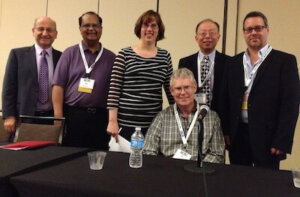
Each year since I first attended the IEEE Electronic Component Technology Conference (ECTC) in 2009, the keynotes, panels and papers focused on 2.5D and 3D integration technologies has increased; every year, that is, until this year. At ECTC 2014, there were not any plenary or panels focused specifically on 2.5D and 3D, and sessions devoted to 3D dropped from 12 to nine. The closest plenary topic to 3D was the Wednesday night panel, titled “Packaging Influence on System Integration and Performance,” moderated by Nancy Stoffel, GE Global Research and fielded by panelists from Microsoft, Cisco, Ericsson Research, IBM and Amkor. Glass and organic interposers were among the hottest topics for 2.5D and 3D; with the featured keynote titled “Glass: The Art, Mythology and Technological Agility of a Material of the Information Age” presented by Peter L. Bocko, PhD, CTO, Corning Glass Technologies; and the CMPT panel addressing organic interposers.
According to ECTC Sponsorship Chair, Dave McCann, GLOBALFOUNDRIES, the reduction in 2.5D and 3D process papers was not a deliberate decision on the program committee’s part, but was a reflection of what the industry is working on now. “We let the work be done by authors dictate what direction the program takes,” he explained. “This year there was more focus on what we can do to bridge the space to 2.5D.” McCann pointed out embedded packaging and fan-out wafer level package (FOWLP) advancements as examples of where the industry is focused to provide higher density solutions that leverage the existing infrastructure today, while we wait for system design people to implement 2.5 and 3D designs and architectures. Additionally, there was more attention paid to the exciting emerging technologies such as Si photonics, flexible and printed electronics.
This is not to say 2.5D and 3D has diminished in importance in the industry; rather just in focus. The processes and technologies have reached maturity. ECTC is a forum for new technologies and developments. Papers are highly academic, and the majority of them are likely to be feasibility and proof-of-concept based. We’re way past that with through silicon via (TSV) and other 3D processes. We’re more concerned now with optimizing processes to help reduce cost and streamline manufacturing; as well as prove reliability. In fact, my colleague Herb Reiter, eda 2 asic, pointed out to me that many of the papers in the 2.5D and 3D space discussed reliability data – something that is only done right before a product is about to go into volume manufacturing.
So while the program elements may have been 2.5D and 3D-lite – the discussions I had during the networking events, and interviews I had in the technology corner with ECTC 2014 exhibitors were anything but. I spoke with a number of vendors about their latest tool introductions and optimizations targeting high volume manufacturing for 3D, and had many discussions about the growing interest in glass interposers; and of course my latest topic focus: how to convince the system designers to start thinking 3D.
On this latter topic, McCann offered up some food for thought. He acknowledged that there is indeed a cost/performance advantage to partitioning SoC designs into disparate technologies and stacking them using 3D IC processes, however die partitioning runs into architecture challenges. “It’s not so straightforward,” he said. “It’s no longer a cost issue, but more of a concern of how to make the product work. It’s a design issue; how do you partition memory, logic, etc.” He also agreed with my assessment that there needs to be more interaction and communication between the communities. Architecture and design teams and the process teams need to figure out a joint solution. To this end, I was excited to see two EDA tool vendors (E-System Design and Mentor Graphics) among the exhibitors. This is unusual and indicative of the growing belief that cross-pollination between the design community and the process and manufacturing community is becoming increasingly important.
This is merely my initial impression of this year’s ECTC 2014. I’ve got lots of blog topics in the hopper based on all the discussions I had last week. Stay tuned. ~ F.v.T.























